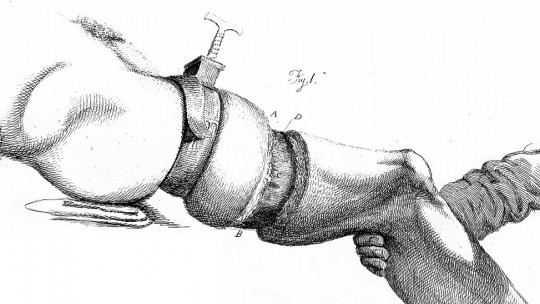
On most occasions we relate sex with the experience of pleasure and pleasant and satisfying sensations. However, in some people these feelings are diametrically opposite. These are cases of sex aversion disorder a type of sexual dysfunction in which the person experiences a strong response of disgust or repulsion to sex in general or to certain specific sexual behaviors or practices.
What is sex aversion disorder?
Also known under the diagnosis of persistent sexual rejection, sex aversion disorder is considered to be a type of sexual dysfunction in which there is a constant or recurring aversion to any type of sexual contact People who suffer from it manifest a clear aversion towards sex, which leads them to avoid sexual contact, especially genital contact, with another person.
Furthermore, sex aversion disorder differs from other sexual disorders in that it first generates repulsion, high levels of anxiety and panic states in the person which experiences them when faced with the possibility of any type of sexual activity.
This feeling of rejection can occur both at the idea of carrying out sexual behaviors or relationships in general, and at specific and specific sexual practices such as oral sex or masturbation.
The incidence of sex aversion disorder is much higher in women than in men and usually represents between 3 and 4% of the reasons for consultation in relation to sexual dysfunctions. Therefore, it is considered an uncommon alteration of sexual behavior.
However, in those cases in which the aversion to sex turns out to be very serious, the person who suffers from it can go to the point of not interacting with any person who could be a potential sexual partner or breaking off a romantic relationship when it gives way. at the beginning of sexual relations.
Types of sex aversion
There are different types of sex aversion disorder. Although they all have in common the feeling of rejection and repugnance towards sex and active avoidance behaviors towards any type of sexual contact, these differ in terms of the moment of appearance and the range or level of affectation.
1. Primary sexual aversion
This first type of aversion to sex refers to those cases in which the person has felt a rejection of sex throughout their life Most of these cases are closely associated with victims of sexual abuse during childhood.
2. Secondary sexual aversion
In these cases the person has come to live their sexuality without any type of difficulty. However, as a result of some experience or situation, this aversion disorder gradually or suddenly develops. Usually this rejection of sex appears in response to a situation of sexual abuse or rape
3. Generalized dislike
In this case, the classification is not based on when the disorder appears, but rather on the degree of affectation it presents. In generalized aversion, the person experiences behaviors of disgust and aversion to sex regardless of the partner or people with whom he or she carries them out.
4. Situational aversion
On the contrary, in situational aversion, the person expresses the rejection of sex with certain specific people or with their partner. This disorder It usually causes numerous conflicts and difficulties within the relationship of the affected person.
What symptoms does it manifest?
As indicated in previous points, the main symptoms that appear in sex aversion disorder It is related to feelings of repulsion and anxiety These symptoms appear due to hyperactivation of the central nervous system, which gives rise to a series of changes and physical alterations such as the following:
Regarding behavioral symptoms, the person can carry out different behaviors that aim to avoid all types of situations or people with whom there is a risk of initiating some type of sexual contact.
These behaviors range from abandoning body hygiene or excessive involvement in any other type of activities that allow you to have an excuse not to have sexual relations.
Differences between this aversion disorder and sex phobia
Although both the physical and behavioral symptoms of sex aversion disorder are similar to those of a sexual phobia, there are significant differences in terms of the cognitive symptoms or feelings that the person experiences in relation to sex.
The main distinguishing characteristic is that while in aversion disorder the emotions are related to repulsion and disgust, In a phobia, the person experiences excessive, irrational, and persistent fear before sexual behaviors.
That is, aversion to sex is associated with other types of emotions other than fear and is usually caused by specific aspects of sexual relations such as secretions or penetration or by specific people. While sexual phobia consists of an experience of extreme fear of sex in general.
What are the causes?
Although the main cause of sex aversion disorder is found in the manifestation of a negative attitude towards it, these attitudes can have various foundations or origins.
In primary type aversions there is usually a basis related to poor sexual education or excessively rigid and restrictive, which considers sex as a harmful, harmful or pernicious act. Sometimes, people raised in very strict religious environments may have been raised under the belief that sex is something sinful, impure or indecent, hence the development of aversion.
As for secondary aversions, these tend to be related to traumatic experiences in relation to sex. Experiences of sexual abuse, rape or the pressure that the partner may exert to maintain some type of sexual activity are the germ of secondary sex aversion disorder.
Is there a treatment?
Because it is a psychological condition, cognitive-behavioral interventions, which include systematic desensitization techniques, have proven to be highly effective in the treatment of sex aversion disorder. However, there are other psychodynamic treatments that, although they require more time, can also be effective.
Thanks to these treatments, people who suffer from sex aversion disorder can see their symptoms decrease and even remit completely, offering them the possibility of leading a normal sexual life.








